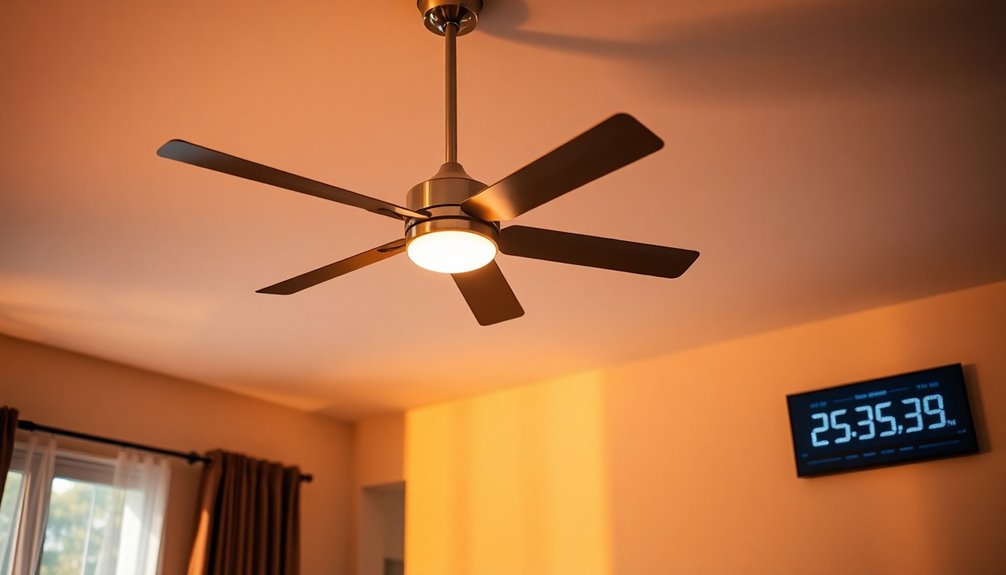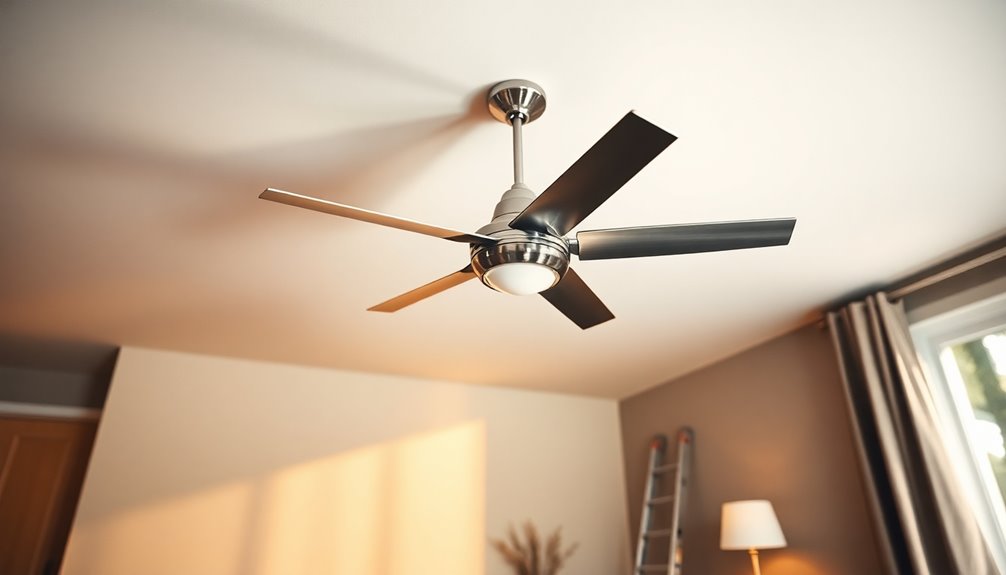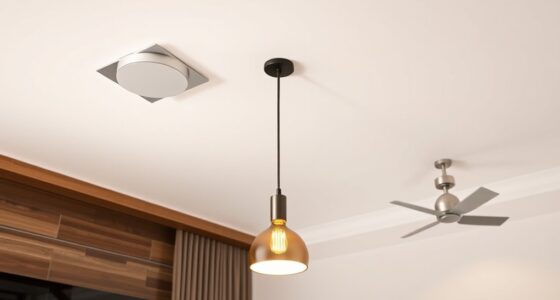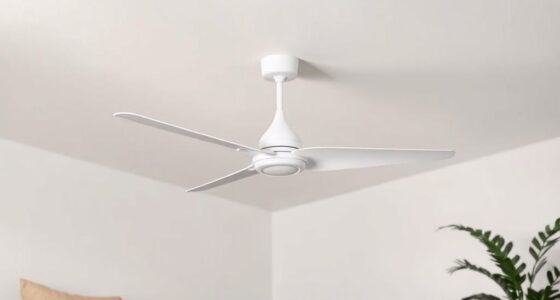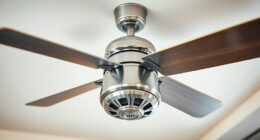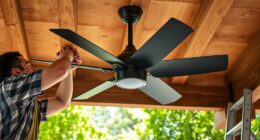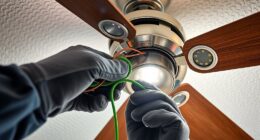Running a ceiling fan isn't expensive, especially when you compare it to air conditioning. Typically, they use about 50 to 80 watts per hour, costing you around $0.05 to $0.18 daily. If you run it for about six hours each day, your annual cost is roughly $18.25. Energy-efficient models, particularly those with DC motors, can save even more on electricity. By using ceiling fans in occupied rooms, you can further minimize costs. Curious about how these little changes can impact your energy bills? Up ahead, you'll discover more useful tips on optimizing fan usage.
Key Takeaways
- Ceiling fans typically consume between 50 to 80 watts per hour, making them relatively inexpensive to run compared to air conditioning systems.
- Daily operating costs for ceiling fans range from $0.05 to $0.18, depending on their wattage.
- Annual costs for running a ceiling fan for 6 hours daily average around $18.25, significantly lower than air conditioning costs.
- Energy-efficient fans with DC motors can save up to 70% on electricity compared to standard AC motor fans.
- Regular maintenance and efficient usage strategies can further reduce operating costs and enhance fan performance.
Understanding Ceiling Fan Costs

When it comes to understanding ceiling fan costs, it's essential to know how much energy they consume. Typically, ceiling fans cost between 50 to 80 watts per hour, while models with lights can ramp up their electricity usage to 175 to 200 watts.
If you run a ceiling fan for about 6 hours daily, you're looking at an annual cost of approximately $18.25. That's considerably less than the cooling costs associated with air conditioning, which could hit $1.20 for the same usage.
To break it down, the average electricity cost in the U.S. is around $0.169 per kilowatt-hour. This means that your daily usage of a ceiling fan can cost between $0.05 to $0.18, depending on its wattage.
By using ceiling fans, you can also set your thermostat higher, allowing for additional energy savings while still enjoying comfort. Energy Star-rated fans are even more efficient, providing up to 60% greater energy savings compared to non-rated models.
Understanding these factors helps you appreciate the cost to run a ceiling fan, making it a smart choice for cooling your space economically.
Comparing Fan Types and Efficiency

When you're choosing a ceiling fan, consider the type of motor it has—DC motors can save you up to 70% on electricity compared to AC motors.
The size of the fan matters too; a larger fan might use more power but can cool a bigger space more effectively.
Additionally, take note of the speed settings, as adjusting them can greatly impact energy efficiency.
AC vs. DC Motors
In the battle of ceiling fan efficiency, AC and DC motors each bring distinct advantages to the table. AC motors are common and typically less expensive upfront, making them an appealing choice for many. However, they're generally less energy-efficient than their DC counterparts.
If you're looking for a ceiling fan that consumes less electricity, DC motors are the way to go. They use about 30-50% less energy for the same airflow output, which can greatly lower your operating costs over time.
DC motors also offer more precise speed control, allowing you to adjust airflow with greater accuracy while keeping power consumption low. Additionally, fans with DC motors tend to operate more quietly, enhancing your comfort in residential settings.
While you might face a higher initial cost when purchasing a DC motor fan, the long-term financial benefits from energy savings can make it a smart investment.
Ultimately, if you want efficiency and quieter operation, consider opting for a DC motor ceiling fan. You'll likely enjoy lower electricity bills and a more comfortable atmosphere in the long run.
Fan Size Impact
Choosing the right fan size is essential for maximizing efficiency and minimizing costs. The size of your ceiling fan directly impacts its energy consumption and, ultimately, your cooling costs. Larger fans typically consume more power; a 52-inch fan uses around 90 watts, while a smaller 36-inch fan operates at just 55 watts.
To help you make an informed decision, here's a comparison of fan sizes, their wattage, and the recommended room size:
| Fan Size | Fan Wattage | Room Size (sq ft) |
|---|---|---|
| 36 inches | 55 watts | Up to 100 |
| 44 inches | 70 watts | Up to 225 |
| 52 inches | 90 watts | Up to 400 |
| 60 inches | 100 watts | Up to 500 |
| Energy Star-rated | Varies | More efficient |
Selecting an Energy Star-rated fan can lead to significant cost savings, as these models can be up to 60% more efficient than non-rated ones. Remember, operating your fan at lower speeds also reduces power consumption, further enhancing your energy efficiency. By choosing the right fan size, you optimize airflow while keeping your energy bills in check.
Speed Settings Efficiency
Ceiling fans come with various speed settings that can greatly influence their energy efficiency. By understanding how these settings affect energy consumption, you can optimize your ceiling fan usage and reduce electricity costs.
- Low Speed: Uses about 30 watts, perfect for gentle airflow and lower energy consumption.
- Medium Speed: Consumes around 55 watts, balancing airflow and efficiency for moderate cooling needs.
- High Speed: Draws around 90 watts, ideal for high airflow but at a higher operating cost.
Energy-efficient ceiling fans, especially those with DC motors, offer superior efficiency over traditional AC motors. They provide the same airflow while consuming less power, which translates to lower operating costs.
Regularly adjusting your fan's speed to match your cooling needs not only enhances comfort but also minimizes energy waste.
Impact of Fan Size on Costs

The size of a ceiling fan considerably influences its running costs and overall efficiency. When choosing a fan, you should consider the wattage it consumes. A small fan, around 36 inches, typically uses about 55 watts, while a larger 52-inch fan can consume approximately 90 watts. This difference in wattage directly affects your monthly electricity costs.
For example, a 52-inch fan averages around $3.46 per month in energy expenses, whereas a 36-inch fan costs about $2.11.
Selecting the right fan size is essential for effective cooling and energy efficiency. A 44-inch fan is suitable for rooms up to 225 square feet, while a 52-inch model can cool spaces up to 400 square feet. Oversized fans in smaller rooms can lead to unnecessary energy consumption, increasing your costs.
Notably, larger fans often operate more efficiently at lower speeds, which can help reduce electricity costs compared to running smaller fans at higher speeds. By carefully considering fan size, you can optimize its energy consumption and keep your cooling costs in check.
Analyzing Fan Speed and Energy Use

Understanding how fan speed impacts energy use is essential for managing your electricity costs effectively. Ceiling fan speed directly influences energy consumption, with higher speeds leading to increased power consumption.
For example, running a fan at high speed can elevate costs to about $0.02 to $0.04 per hour, compared to just $0.01 to $0.02 per hour on low speed.
Consider the following factors when adjusting your ceiling fan speed:
- Cooling Needs: Use lower speeds during milder temperatures to maintain comfort without overspending.
- Operating Cost: Running a fan on low speed for 8 hours could cost you only $0.08 to $0.16, while high speed may double that.
- Energy Efficiency: Opt for energy-efficient ceiling fans with DC motors, which can reduce power consumption by up to 60%.
Adjusting your fan speed according to your thermostat settings can help you optimize both comfort and costs.
Strategies for Reducing Energy Bills

Managing your energy costs goes beyond just adjusting fan speeds; it involves implementing smart strategies that maximize efficiency. One effective strategy is to use ceiling fans only when rooms are occupied. This simple adjustment can considerably reduce energy costs, with operating costs typically ranging from $2 to $5 per month. Additionally, using energy-efficient heat pumps in conjunction with ceiling fans can further enhance your overall energy savings. Modern heat pumps designed with quieter operation in mind contribute to a more comfortable atmosphere when paired with ceiling fans. Furthermore, incorporating home security systems can protect your home while also enhancing your overall energy management.
Consider setting your ceiling fans to lower speed settings. Higher speeds consume more electricity, costing about $0.01 to $0.02 per hour.
Regular cleaning and maintenance are also essential; ensuring ideal performance can save you up to 60% in energy costs compared to non-rated models.
Pairing ceiling fans with your air conditioning is another great way to save energy. By using fans, you can increase your thermostat settings by up to 4°F, effectively reducing air conditioning costs without sacrificing comfort.
Additionally, investing in energy-efficient fans, like those rated by ENERGY STAR, can lead to considerable long-term savings, with annual costs for efficient models potentially as low as $8. Implementing strategies such as utilizing air purifiers can further enhance indoor comfort, promoting better air quality while reducing the need for intensive cooling.
Ceiling Fans vs. Air Conditioning Costs

When it comes to cooling your home, ceiling fans offer a notably lower cost alternative to air conditioning. The cost of running ceiling fans is considerably less, making them an economical choice for daily usage.
Here's a quick comparison to evaluate:
- Monthly Costs: Running a ceiling fan typically costs between $2 to $5, while air conditioning can reach over $81.50 annually.
- Electricity Consumption: Ceiling fans use about 0.6 kWh to 0.9 kWh daily compared to air conditioners, which consume between 28 kWh to 42 kWh.
- Daily Expenses: Operating a ceiling fan for 8 hours costs around $0.24 to $0.48, compared to the $1.20 for air conditioning.
Frequently Asked Questions
Do Ceiling Fans Use a Lot of Electricity?
You might be surprised to learn that ceiling fans don't use a lot of electricity. Typically, they consume between 50 to 90 watts per hour, which is minimal compared to air conditioners.
If you run a standard fan for about 8 hours daily, it'll only cost you around $2 to $5 per month. By using energy-efficient models, you can save even more, making ceiling fans an economical choice for cooling your space.
How Much Does It Cost to Run a Ceiling Fan 24 Hours a Day?
Running a ceiling fan for 24 hours a day typically costs you between $1.68 and $4.32 each month, depending on the fan's wattage and your local electricity rates.
For instance, a 75-watt fan might cost you about $0.30 daily, while a more energy-efficient 38-watt model could be as low as $0.15.
Can Ceiling Fans Cause a High Electric Bill?
Ceiling fans generally won't cause a high electric bill. They consume relatively low wattage—typically between 50 to 80 watts—making them a cost-effective choice for cooling.
When you use one for several hours a day, you're likely looking at just a few dollars monthly. Of course, factors like fan size and speed can affect energy use.
Is It Cheaper to Run Ceiling Fans or Air?
When it comes to cooling your space, you'll find that running ceiling fans is a no-brainer.
They use considerably less energy than air conditioning units, saving you a pretty penny each month. If you run a fan for just a few hours, it costs less than a dime compared to the dollars an AC unit can rack up.
Conclusion
To sum up, ceiling fans are generally cost-effective when it comes to running expenses. For instance, if you use a ceiling fan instead of air conditioning on warm days, you could save about $30 a month on your energy bill. By choosing an energy-efficient model and optimizing its use, you can keep your home comfortable without breaking the bank. So, next time you're feeling hot, consider turning on that fan before cranking up the AC!
